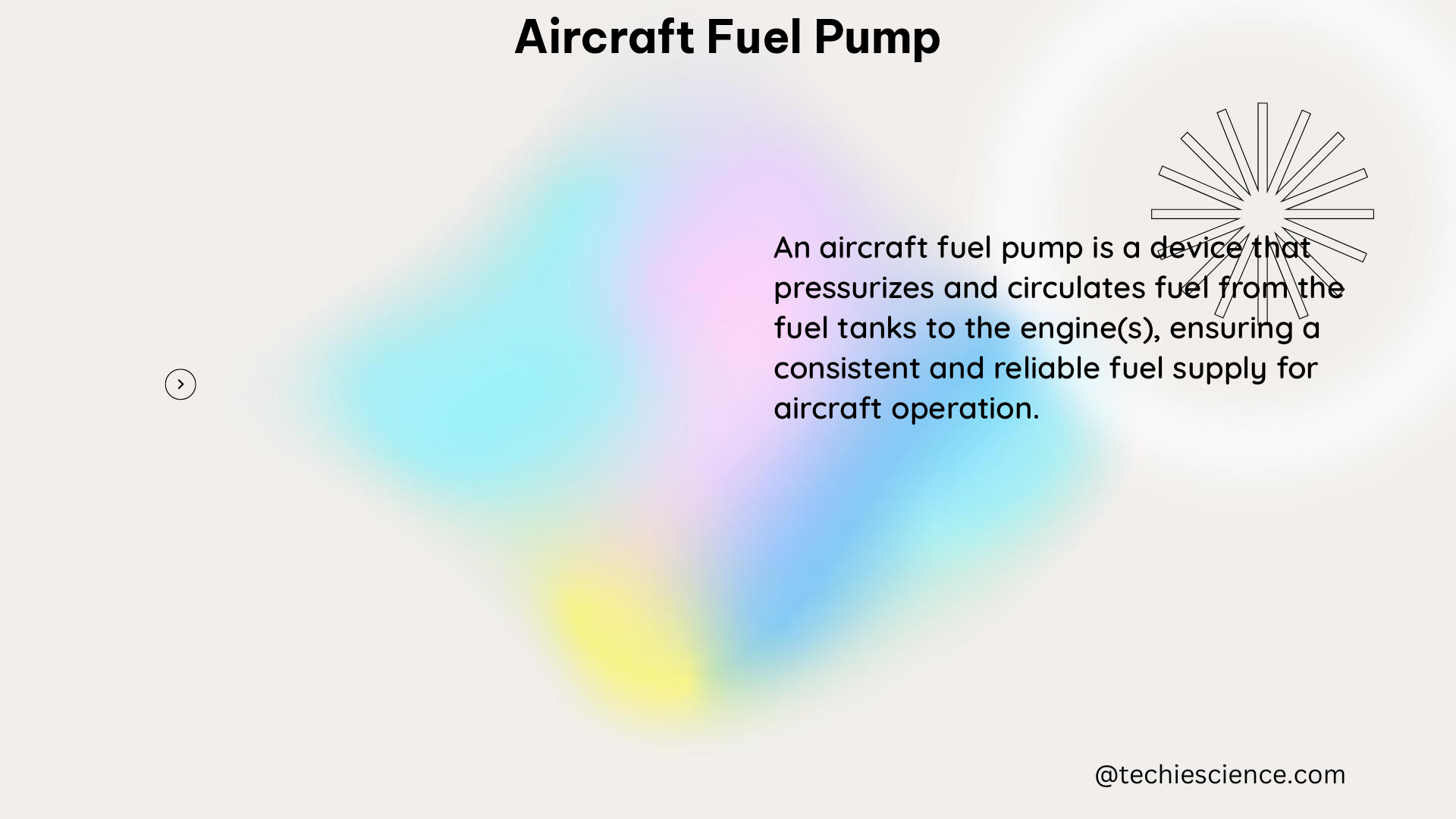Aircraft fuel pumps are critical components of aircraft fuel systems, responsible for delivering fuel to the engines at the required pressure and flow rate. These pumps play a vital role in ensuring the safe and efficient operation of aircraft, making them a crucial area of study for aviation enthusiasts, engineers, and maintenance professionals.
Understanding the Flow Rate of Aircraft Fuel Pumps
The flow rate of an aircraft fuel pump is the volume of fuel it can deliver per unit time, typically measured in gallons per minute (gpm) or pounds per minute (lbm/min). This parameter is crucial in determining the pump’s ability to meet the fuel demands of the aircraft’s engines.
The flow rate of a fuel pump is governed by the pump’s design, including factors such as the impeller size, rotational speed, and the pump’s internal geometry. The flow rate can be calculated using the following formula:
Q = ρ × V × A
Where:
– Q is the volumetric flow rate (gpm or lbm/min)
– ρ is the density of the fuel (typically around 6.7 lbs/gallon for Jet A fuel)
– V is the velocity of the fuel through the pump (ft/s)
– A is the cross-sectional area of the pump’s outlet (ft²)
For example, a typical aircraft fuel pump might have a flow rate of 50-100 gpm, which would be sufficient to meet the fuel demands of most commercial and military aircraft.
Analyzing the Pressure Characteristics of Aircraft Fuel Pumps

The pressure of an aircraft fuel pump is the force it exerts on the fuel to deliver it to the engines. This parameter is typically measured in pounds per square inch (psi) or pascals (Pa). The pump’s pressure characteristics are crucial in ensuring that the fuel is delivered to the engines at the required pressure, which is typically in the range of 30-50 psi.
The pressure generated by a fuel pump can be calculated using the following formula:
P = ρ × g × h
Where:
– P is the pressure (psi or Pa)
– ρ is the density of the fuel (lbs/ft³ or kg/m³)
– g is the acceleration due to gravity (32.2 ft/s² or 9.81 m/s²)
– h is the height of the fuel column (ft or m)
It’s important to note that the pump’s pressure characteristics can be affected by factors such as the fuel system’s design, the aircraft’s altitude, and the pump’s operating speed.
Evaluating the Power Consumption of Aircraft Fuel Pumps
The power consumption of an aircraft fuel pump is the amount of electrical power it requires to operate, typically measured in watts (W) or horsepower (hp). This parameter is crucial in determining the overall power requirements of the aircraft’s electrical system and the fuel pump’s energy efficiency.
The power consumption of a fuel pump can be calculated using the following formula:
P = Q × ΔP / η
Where:
– P is the power consumption (W or hp)
– Q is the volumetric flow rate (gpm or lbm/min)
– ΔP is the pressure rise across the pump (psi or Pa)
– η is the pump’s efficiency (typically 80-90% for aircraft fuel pumps)
For example, a typical aircraft fuel pump might consume 500-1000 watts of power, which would be a significant portion of the aircraft’s overall electrical power budget.
Assessing the Efficiency of Aircraft Fuel Pumps
The efficiency of an aircraft fuel pump is the ratio of the useful work it performs (i.e., delivering fuel to the engines) to the energy it consumes. This parameter is typically measured as a percentage and is an important indicator of the pump’s performance and energy usage.
The efficiency of a fuel pump can be calculated using the following formula:
η = (Q × ΔP) / P
Where:
– η is the pump’s efficiency (%)
– Q is the volumetric flow rate (gpm or lbm/min)
– ΔP is the pressure rise across the pump (psi or Pa)
– P is the power consumption (W or hp)
A typical aircraft fuel pump might have an efficiency of 80-90%, which is relatively high compared to other types of pumps used in industrial applications.
Considering the Weight of Aircraft Fuel Pumps
The weight of an aircraft fuel pump is an important consideration in aircraft design, as it affects the overall weight and fuel efficiency of the aircraft. This parameter is typically measured in pounds (lb) or kilograms (kg).
The weight of a fuel pump is primarily determined by its size, materials of construction, and the complexity of its design. Lighter-weight materials, such as titanium or aluminum, are often used in aircraft fuel pump construction to minimize the overall weight of the aircraft.
For example, a typical aircraft fuel pump might weigh 10-20 lb, which would be a significant portion of the aircraft’s overall weight budget.
Monitoring the Temperature of Aircraft Fuel Pumps
The temperature of an aircraft fuel pump is an important consideration in its operation, as it can affect the pump’s performance and longevity. This parameter is typically measured in degrees Celsius (°C) or Fahrenheit (°F).
The temperature of a fuel pump can be affected by factors such as the ambient temperature, the temperature of the fuel being pumped, and the pump’s operating conditions. Excessive temperatures can lead to increased wear and tear on the pump’s components, as well as potential fuel degradation.
To maintain the pump’s optimal operating temperature, aircraft fuel systems often incorporate cooling mechanisms, such as heat exchangers or fuel-oil coolers. These systems help to regulate the temperature of the fuel and the pump, ensuring that the pump operates within its designed temperature range, typically 50-100 °C.
Technical Specifications and Maintenance Requirements
In addition to the quantifiable data points discussed above, it is also important to consider the technical specifications and maintenance requirements of aircraft fuel pumps. These include:
-
Materials of Construction: Aircraft fuel pumps are typically constructed from corrosion-resistant materials, such as stainless steel or titanium, to ensure their durability and reliability in the harsh operating environment of an aircraft.
-
Operating Limits: Fuel pumps have specific operating limits, such as maximum pressure, temperature, and speed, which must be adhered to in order to ensure their safe and reliable operation.
-
Maintenance Requirements: Regular maintenance, such as cleaning, lubrication, and replacement of worn parts, is essential for maintaining the performance and longevity of aircraft fuel pumps. Maintenance schedules and procedures are typically outlined in the aircraft’s maintenance manuals.
-
Redundancy and Backup Systems: Many aircraft fuel systems incorporate redundant fuel pumps and backup systems to ensure that the aircraft can continue to operate safely in the event of a fuel pump failure.
-
Monitoring and Diagnostics: Advanced aircraft fuel systems may incorporate monitoring and diagnostic systems to track the performance and health of the fuel pumps, allowing for predictive maintenance and early detection of potential issues.
By understanding the technical specifications and maintenance requirements of aircraft fuel pumps, aviation professionals can ensure that these critical components are properly maintained and operated, contributing to the overall safety and reliability of the aircraft.
Conclusion
Aircraft fuel pumps are essential components of aircraft fuel systems, responsible for delivering fuel to the engines at the required pressure and flow rate. By understanding the key performance characteristics of these pumps, such as flow rate, pressure, power consumption, efficiency, weight, and temperature, aviation professionals can ensure that the fuel system is designed and operated to meet the specific requirements of the aircraft.
Additionally, considering the technical specifications and maintenance requirements of aircraft fuel pumps is crucial for maintaining their performance and longevity, ultimately contributing to the overall safety and reliability of the aircraft.
References:
- Moir, I., & Seabridge, A. (2011). Aircraft Systems: Mechanical, Electrical, and Avionics Subsystems Integration. Wiley John & Sons.
- Langton, R., Clark, C., Hewitt, M., & Richards, L. (2010). Aircraft fuel systems. In Encyclopedia of Aerospace Engineering. Wiley John & Sons.
- Zhang, Q., Lin, G., Guo, J., Jin, H., & Zhang, Q. (2023). Optimization Research on the Heat Transfer Capacity of an Aircraft Fuel Thermal Management System. Aerospace, 10, 730.
- Ford, T. (1998). The Boeing 777 fuel system. Aircr. Eng. Aerosp. Technol., 70, 199–202.
- Birta, L. G., & Arbez, G. (2013). Modelling and Simulation. Springer.
- Gill, S. S., Tuli, S., Xu, M., Singh, I., Singh, K. V., Lindsay, D., Tuli, S., Smirnova, D., Singh, M., Jain, U., et al. (2019). Transformative effects of IoT, Blockchain and Artificial Intelligence on cloud computing: Evolution, vision, trends and open challenges. Internet Things, 8, 100118.
- García, F. J., Doblado, J. A., García, J. M. M., Álvarez, D., Vilar, J. R. P., & Sánchez, T. S. (n.d.). Big Data in Aeronautics: Application to the Predictive Maintenance of the Landing Gear. Available online.

I have a background in Aerospace Engineering, currently working towards the application of Robotics in the Defense and the Space Science Industry. I am a continuous learner and my passion for creative arts keeps me inclined towards designing novel engineering concepts.
With robots substituting almost all human actions in the future, I like to bring to my readers the foundational aspects of the subject in an easy yet informative manner. I also like to keep updated with the advancements in the aerospace industry simultaneously.